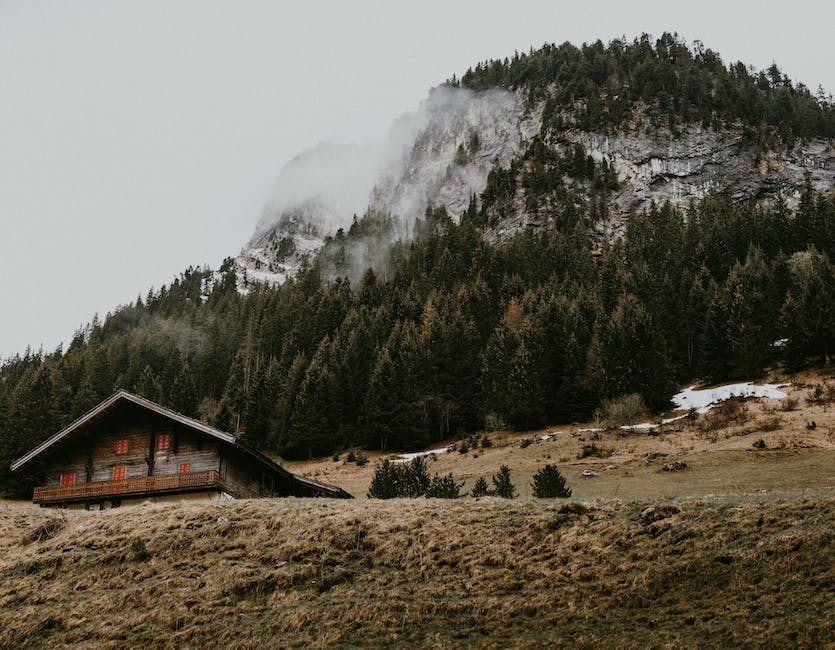A pine tree should be at least 10 feet away from a house. If a pine tree is too close to a house, it can cause damage to the foundation and walls.
There is no definitive answer to this question as the ideal distance between a pine tree and a house will vary depending on the size of the tree and the size of the house. However, as a general rule of thumb, it is generally recommended that a pine tree be planted at least 20 feet away from a house.
Do pine trees cause foundation problems?
Pine trees have roots that extend straight down into the soil, so they have almost no impact on your foundation.
Tree roots can damage a house foundation by growing and penetrating into friable soils and mulch. This can create an invitation for further damage as the roots can continue to grow and destabilize the foundation.
How close is too close for a tree to a house
A tree should be planted at least fifteen feet away from the foundation of a home to allow for the growth of the roots and to prevent damage to the foundation. For larger, overstory species (taller than sixty feet), that distance should be increased to at least twenty feet from foundations and landscape features.
Pine tree roots typically grow straight down, so they don’t usually pose a risk to a home’s foundation. However, there are other types of tree roots that can be problematic for a home’s foundation. Hardwoods such as oaks and elms are the most concerning type of tree in this regard.
When should a pine tree be removed?
A pine tree that has all brown needles is a dead tree and should be removed. A pine that dies slowly after being damaged in a storm may keep yellow-green needles for a year or more and then suddenly turn yellow and quickly progress to brown.
If you see any brown spots on a pine needle, it is possible that the tree has a disease. To be sure, examine a few needles from different parts of the tree. If you see any brown stripes or clumps in the center of the needle, this is a sign of disease.
What are the disadvantages of pine trees?
Pine trees have many disadvantages. Their needles and cones can be a nuisance, they exude a sticky sap, and they require an acidic soil pH to thrive.
Pine trees are generally low maintenance and don’t require a lot of pruning. However, if there is damage to a limb or the tree, you may need to do some corrective pruning.
What is the lifespan of a pine tree
Pines are a type of evergreen tree that are long lived and typically reach ages of 100–1,000 years, with some even living longer. The Great Basin bristlecone pine (P longaeva) is thought to be the longest lived pine species, with one individual, dubbed “Methuselah”, believed to be around 4,800 years old – making it one of the oldest living organisms in the world.
Pine trees have a taproot system, which means that the roots grow straight down from the trunk of the tree. The taproot is the thickest and most prominent root, and it can grow to be as thick as the tree trunk itself. The taproot can grow to be several feet long, and it anchors the tree in the ground. The taproot also stores nutrients and water for the tree. The smaller, thinner roots that grow from the taproot are called lateral roots. These roots spread out in all directions, forming a dense network under the ground. Lateral roots can grow to be several feet long, but they are usually only a few inches thick.
Do pine tree roots go deep?
Pine trees have a root system that can extend away from the tree at a distance as much as twice the height of the tree. The roots of pine trees, notably Ponderosa pine trees, tend to be deep tap roots with a shallower root system (12 inches or shallower from the ground surface level).
While it’s unlikely you’ll be refused a policy outright because of a large tree near your home, it’s possible that your premium could be higher than average because of the potential damage the tree could cause. Be sure to read the terms and conditions of your policy carefully to see if there are any exclusions for trees, and If you’re still unsure, contact the insurer directly.
Do pine trees deplete the soil
As a result of this, it is recommended that gardeners avoid planting pines too close to other trees or plants.
There are many different types of trees that can cause foundation issues. The most common are oaks, poplars, and ash trees, but there are many others that can also be problematic. Deciduous trees such as the black locust, boxelder, Norway maple, silver maple, sweetgum, sycamore, and tuliptree can all cause issues with foundations. It is important to be aware of all the different types of trees that can cause problems so that you can be sure to avoid them.
Do pine trees ever stop growing?
While trees do eventually reach a point where they stop growing taller, they continue to add width to their trunks and put out new leaves and branches throughout their lives. This process helps them to stay healthy and continue to thrive.
Pine trees are an excellent addition to any lawn. They are evergreen, tall, and have a fencing feature that can really add value to your landscape. They are also relatively easy to take care of.
Should you cut dead branches off pine tree
If you have a pine tree on your property that is starting to look unhealthy, you may need to trim it back. Remove any lower branches that are dead, dying, or damaged. This will help the tree to recover and become healthy again. When trimming, avoid cutting the limb flush with the trunk. This will help the wound to heal properly.
When a large evergreen tree is topped, the upper main stem is removed. This opening can internal decay, disease, or damaging insects. Topping also removes the most productive portion of the tree.
How do you know when a pine tree is going to fall
If you see your pine tree leaning significantly or if its roots are visibly uprooted or sinking, these could be signs that the tree is about to fall. Other warning signs include dead branches, fungus growth, cavities, and soil displacement. If you notice any of these signs, it’s best to call a certified arborist to assess the situation and determine the best course of action.
Pine and fir needles, as well as fallen branches and pine cones, can create a significant fire hazard if left on or around a property. Raking them off of hard surfaces and removing them from the soil within 30 feet of all structures can help prevent a fire from starting or spreading.
Which trees are most likely to fall
Wind is a major factor in tree falls, and the willow, white spruce, cedar, and white pine are among the species most likely to be toppled by strong gusts. These trees typically grow in wetter soils, which can make them more vulnerable to falling. To minimize the risk of wind damage, homeowners should consider planting trees that are native to their region and that are known to be resistant to high winds.
Pine trees are excellent for erosion control because their roots hold soil in place, and the layers of pine needles help to soften the impact of falling rain. They are also tolerant of sun, drought, and cold, making them suitable for a wide range of soil conditions.
Are pine trees less likely to fall
According to Scow, evergreen trees are more likely to come down because their canopy is always present and it’s thick and heavy. This creates a “windsail effect” that makes the tree more susceptible to high winds.
Pines are the evergreen trees that are distinguished by their needle-like leaves and cone-shaped fruit. The different species of pine trees can vary greatly in terms of their growth rate. Medium-fast growing pine trees, like the red pine and the Australian pine, typically grow 1-2 feet per year. Fast growing pines, like loblolly pines and scotch pines, can often grow two feet or more in a single year.
Warp Up
A pine tree should be located at least 20 feet from a house.
In conclusion, the answer to how far a pine tree should be from a house depends on various factors such as the type of pine tree, the climate, and the surrounding area. If you are unsure, it is best to consult with a professional to get the most accurate answer for your specific situation.
Mark Hoffman is a dedicated arborist and tree care specialist with over a decade of experience. His love for trees began when he visited Yosemite National Park as a teenager and was awestruck by the giant sequoias. Mark pursued his passion by studying forestry at Michigan Technological University, where he earned a Bachelor of Science degree.
Since then, he has worked tirelessly in the field of arboriculture, helping to preserve and protect trees in his community. His expertise and dedication have made him a respected leader in the industry and a valuable resource for anyone seeking advice on tree care.
